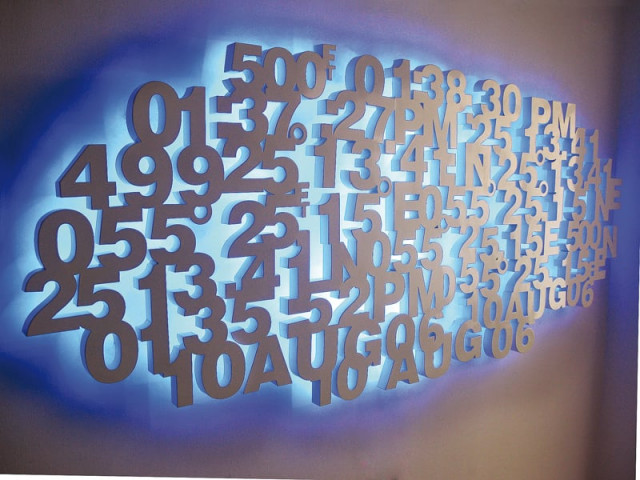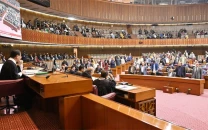Abu Dhabhi Art: 'Beyond' - let art be limitless
Abu Dhabi Art’s ‘Beyond’ initiative introduces monumental pieces of art in public spaces

Like the projects above, Abu Dhabi Art was initiated by the Abu Dhabi Tourism & Culture Authority (TCA Abu Dhabi) to bring together some of the world’s most innovative galleries, artists, cultural leaders and collectors from across the globe. It is now in its sixth year. ‘Beyond’ is one of its five exhibition platforms which aims to introduce art in public spaces. This year, through a new annual selection of large-scale art installations, ‘Beyond’ is on display in public areas throughout the city for six months. It features works by 14 well-known artists, including Ai Weiwei, Subodh Gupta, François Morellet, Mohammed Kazem, Shilpa Gupta, Virginie Yassef and Sahand Hesamiyan.

Subodh Gupta Et tu, Duchamp? 2009/2010. PHOTO: ABU DHABI ART
Ai Weiwei is a politically charged artist whose works revolve around pertinent issues, either from his native China or all over the world. These range from his issues with authorities in China to natural disasters. At ‘Beyond’, represented by Lission Gallery, he displays his widely-exhibited installation, Forever. It features stacked and layered stainless-steel cycle frames that give different views from each angle and remind one of a production assembly line. It reflects a world embroiled in consumerism, where products are mass-produced and eagerly sought by people to ‘fit in’. It also reveals a fusion of tastes today, where profit-making corporations exploit homogeneity of preferences. Wei Wei’s idea behind the installation, however, was more personal. He mentions, “The bicycle is an object we grew up with. Owning a bicycle was a luxury then, and everyone aspired to have a ‘Forever’ bicycle, which was the best brand at the time.” Inspired by Marcel Duchamp’s ‘readymades’ (ordinary manufactured objects that the artist selected and modified), and the familiarity of the bicycle world over, Weiwei looks at the changing landscape and attitude of people through this symbol. While ironically, the Forever bicycle is disappearing in China — increasingly replaced by polluting cars — the Western world is going back to this eco-friendly mode of transport.

François Morellet Pier and Ocean, 2014. PHOTO: ABU DHABI ART
Another Duchamp fan is Indian artist Subodh Gupta. With his sculpture Et tu, Duchamp?, represented by Hauser and Wirth gallery, he takes the ‘readymade’ to a new level. Inspired by Duchamp’s 1919 version of Mona Lisa — moustached, goateed and titled L.H.O.O.Q. — Gupta converts the painting into a huge bronze sculpture covered with black patina. Interestingly, this work ends up being an appropriation of an appropriation, as well as a direct engagement with works from art history.
By making Duchamp’s version of the Mona Lisa his own, as well as monumentalising it, Gupta has taken possession of the idea of conceptual art and gives appropriation a new dimension. What’s also intriguing is that while the original Mona Lisa lies in the heart of the Louvre in Paris, Gupta’s version is now on exhibition where the Louvre Abu Dhabi exists — another appropriation of sorts perhaps.
François Morellet’s work is characterised by clear geometric forms, which are usually described by seemingly factual lines. His installation Pier and Ocean, represented by Kamel Mennour Gallery, displays neon tubes in a room, distributed in two different line systems: vertical-horizontal and diagonal. Morellet draws inspiration by Piet Mondrian’s drawing series, where the abstract sea consists of horizontal and vertical lines. Upon entering the room, the visitor views the horizontal and vertical, glowing neon lights and walks on a pier. The glowing lamps remind one of a calm sea, until an invisible sensor detects one’s presence. The second system of diagonal neon tubes is then switched on automatically, changing the impression of a calm water surface into a rough sea.

Ai Weiwei Forever, 2013. PHOTO: ABU DHABI ART
Sahand Hesamiyan’s stainless steel sculpture, presented by The Third Line Gallery, represents an object washed ashore by the waves. According to the artist, “The form, shape and position of the lines allows people to discover new perspectives by walking around it… Like an object drifting in from the sea that will be explored by people who find it, this piece is being brought to the ‘Beyond’ section of Abu Dhabi Art from far away, to be explored by yet another group of people.”
Mohammed Kazem’s Directions (Circle) displays a cluster of dates, timings and coordinates in white acrylic, aluminum and light-emitting diode light. Represented by Gallery Isabelle van den Eynde, this piece is a reminder of our world that is continuously on the go, and how time and space influence our lives so completely.
Being presented together in Abu Dhabi at ‘Beyond’, all the installations influence and create dialogue with one another, thus, adding to their meaning. As a public art project, ‘Beyond’ is a great initiative and will do well to engage audiences from all over.
Shanzay Subzwari is a fine arts student. She tweets @ShanzaySubzwari
Published in The Express Tribune, Sunday Magazine, November 16th, 2014.



















COMMENTS
Comments are moderated and generally will be posted if they are on-topic and not abusive.
For more information, please see our Comments FAQ